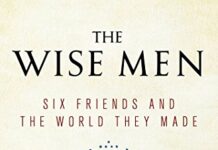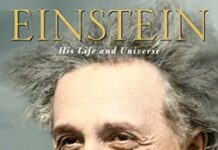
Ebook Info
- Published: 2017
- Number of pages: 625 pages
- Format: PDF
- File Size: 40.10 MB
- Authors: Walter Isaacson
Description
The #1 New York Times bestseller from Walter Isaacson brings Leonardo da Vinci to life in this exciting new biography that is “a study in creativity: how to define it, how to achieve it…Most important, it is a powerful story of an exhilarating mind and life” (The New Yorker).Based on thousands of pages from Leonardo da Vinci’s astonishing notebooks and new discoveries about his life and work, Walter Isaacson “deftly reveals an intimate Leonardo” (San Francisco Chronicle) in a narrative that connects his art to his science. He shows how Leonardo’s genius was based on skills we can improve in ourselves, such as passionate curiosity, careful observation, and an imagination so playful that it flirted with fantasy. He produced the two most famous paintings in history, The Last Supper and the Mona Lisa. With a passion that sometimes became obsessive, he pursued innovative studies of anatomy, fossils, birds, the heart, flying machines, botany, geology, and weaponry. He explored the math of optics, showed how light rays strike the cornea, and produced illusions of changing perspectives in The Last Supper. His ability to stand at the crossroads of the humanities and the sciences, made iconic by his drawing of Vitruvian Man, made him history’s most creative genius. In the “luminous” (Daily Beast) Leonardo da Vinci, Isaacson describes how Leonardo’s delight at combining diverse passions remains the ultimate recipe for creativity. So, too, does his ease at being a bit of a misfit: illegitimate, gay, vegetarian, left-handed, easily distracted, and at times heretical. His life should remind us of the importance to be imaginative and, like talented rebels in any era, to think different. Here, da Vinci “comes to life in all his remarkable brilliance and oddity in Walter Isaacson’s ambitious new biography…a vigorous, insightful portrait” (The Washington Post).
User’s Reviews
Reviews from Amazon users which were colected at the time this book was published on the website:
⭐A gentleman that I know once remarked to me that in his home, with his family, weirdness is not tolerated; excellence is expected. I just smiled politely. He emphasized it to me again, excellence not weirdness. I thought to myself, how cliché. How original it is to trot out a worn-out theme, another dull and tiresome platitude, to run your family and your home. I guess there will not be any Leonardo(s) emanating from that family for Leonardo was the embodiment of so called weirdness. Leonardo was something different and something more than the quotidian and pedestrian excellence demanded by the contingencies of his time and place, or ours for that matter. Weirdness, I submit, is the beginning of creativity, originality in art, literature, poetry and dare I say it, in philosophy. Leonardo was weird? Yes, of course he was, what of it? Leonardo’s weirdness challenges our comfortable expectations and conventional definitions of what is ‘normal’. Weirdness is often the path to creativity, or should I say, the springboard across the chasm of the normal, to the summit of the ingenious? Leonardo is a key figure in the history of weirdness and weirdos that has elevated the human condition. Leonardo helps us widen our perspective and deepen our reservoirs of tolerance for what we might find to be weird and how the weird, once embraced, becomes part of an updated ‘normal’, and creates a new excellence. It would seem that many can stand to learn this lesson today. If Leonardo lived a century later, I believe it likely that he would have been condemned as a heretic in much the same manner as Bruno and Galileo. For example, Leonardo rejected the teaching of the Catholic Church on the soul, the flood, or the fetus. In the Counter-Reformation world to come, Leonardo would be a heretic.The book itself is organized into short chapters which make for bite-size chunks of reading, a convenience for readers so inclined. However, this disrupts the narrative flow and gives the book a chunky feel. The book is more of a recounting or retelling of events and facts rather than a true literary work. By this I mean, many of the chapters are self-contained silos that focus on a particular work of art, project or aspect of Leonardo’s life. The chapters become individual case studies without providing an understanding of the context in which many these events were proceeding simultaneously in the progress of Leonard’s career and life. Thus, Leonardo does not start to come into full perspective until one is well near the end of the book. In sum, set piece chapters can be useful even enhancing to a narrative biography but in this case, I think the book is too compartmentalized. In life of course, the compartments overlap each other but this sense of overlap is not adequately conveyed in the book. In fairness to Walter Isaacson, Leonardo’s life was so intricate and dynamic, intertwined with motion and emotion, fact and fantasy, just like his art, that perhaps Isaacson had to resort to a compartmentalized presentation in an effort to achieve completeness but in this quest for completeness, something of the artistic rendering, the feel itself for the person, is lost. Having said this, I would be remiss not to mention that the book is lavishly illustrated and that one of the great pleasures to be found in reading the book is in the use of a magnifying glass to study the many well rendered artistic, anatomical and mechanical illustrations.If this review has not been critical enough, I must remark that Walter Isaacson provides what is nearly a hagiography rather than a biography. Why is Leonard given a pass, so to speak, for his collaboration with Caesar Borgia? Machiavelli is too often criticized for his description of the optimal political leader, of and for his time and place, with the use of Caesar Borgia as his model of The Prince. But all Machiavelli did was to write a book. Leonardo Da Vinci actually worked for Borgia as a military engineer and this is overlooked as just an innocent and passing fancy by Isaacson. I found that Isaacson goes too far out of his way in trying to find excuses for this collaboration with, in Isaacson’s own words, “…the most brutal murderer of the era…” It seems to me that Leonardo just ‘did’ without thinking about what he was ‘doing’. I do not believe that Leonardo was taking a political position or endorsing the ambitions of Borgia, but he was more concerned about practicing his art as a military engineer without concern for the implications and ramifications of that art practiced in the service of Caesar Borgia, or in the service of any other patron. This, I submit, is an ethical failing, a failure to think and Isaacson’s whitewash does not cover this failing. Much of ethics comes in the honest thinking through and about the consequences of what we are doing before we do it. That is, in simply paying attention to what are doing. This is where Leonardo fails, by paying attention only what he ‘did’ and not to what he was ‘doing’. However, no matter what, I still do adore Leonardo’s art, after all, he could also paint even though he preferred to think of himself as more than “…merely a painter.” I still prefer him as merely a painter. Perhaps we will have to just settle for the fact that Leonardo was self-contradictory enigma, a pacifist who worked as a military engineer. This must have taken great feats of cognitive dissonance and psychological compartmentalization to pull off.Lastly, almost, Leonardo shows us that the physical is spiritual, and that the spiritual is physical. I believe that the dichotomy between what is spiritual (or mental) and what is physical is a deep metaphysical error. This privileging of the binary over the unity results in a binary reductionism of the human condition. Some people even go so far as to state this in terms of the spiritual versus the physical as if there is some natural antipathy between the two when alternatively, we can find unity if we look again. By unity I do not mean a simple oneness. Rather, I mean a reality that is multi-faceted with unclear distinctions, many shades of meaning and blurred lines of distinction without clear delineations that give rise to easy bifurcations. Leonardo shows us how to look again and more deeply and arrive at this alternative, I believe superior, description of our reality. This binary reductionism is also the error of most religions including the three monotheistic impostor religions. Leonardo shows us in his later portraits of John the Baptist that the seductive and sensuous complement, they do not clash with, the spiritual and the divine. For so long as the essential relationship between the physical and spiritual remains expunged from our thinking and for so long as this false dichotomy is forced upon us – we will have to look back to non-monotheistic and pre-Christian thinking to find examples of this healthy relationship. Flesh and spirit, and the pleasures of each, are two aspects of the same essential human way of being in the world. The separation has been a great loss to human well-being. Leonardo was also precocious in his showing us the ultimate human dichotomy, the one that we do not notice because we see it and live it every day, that of male and female. His is brave and playful in overcoming of this with his depiction of the transgender Angel Incarnate, the ultimate overcoming of the old binary with a new unity. The recognition that each of these dichotomies are really one in the same is the path to human flourishing. Leonardo’s depictions of androgynous angels and saints are consistent with his insightful merging of erotic arousal with spiritual aspiration. This goes deeply into what it means to be fully human. This is Leonardo’s great and underappreciated contribution that Isaacson brings to light, the blurring of often thought bright lines such as those between fantasy and reality and the breaking down of walls, such as those between science and art.In closing this review, finally, I will have the temerity to now disagree with Master Leonardo himself. Leonardo tells us that “…so a well-employed life brings a happy death.” This is just so much nice happy talk. A fantasy and a rationalization. Rather, I submit for consideration, that it is a pretend life amounting to nothing that makes death easy for there is nothing lost in death. Much, I think, would be lost in death after a well-employed life, this is what makes death tragic in such cases, not happy. The advantage of a life of no account is to gain mastery over death in the form of indifference. Indifference to life leads to indifference to death. This I submit, is the only mastery over death available to us.
⭐Everyone knows his work. It’s impossible not to know the Mona Lisa, the Last Supper, and the spread-eagled Vitruvian Man; but the man himself casts no easy shadow. After years of painstaking research, Walter Isaacson’s biography gives us probably the most complete portrait of this paradoxical genius. Briefly, Leonardo was the bastard son of a successful Notary, which was a bigger deal back then than today. Legitimate children were expected to follow in their father’s footsteps, but being a bastard as well as bright, Leonardo was free to follow his fancies. A homosexual dandy with a taste for flashy clothes, feminine boys, and an insaisable curiousity about nature, Leonardo basically worked only to support his research into the natural world, making discoveries about light, water, and anatomy (he dissected innumberable human and animal corpses, learniing how the heart, muscles, and nerves worked) far ahead of their time and recording them all as drawings or scribbled writings in his many notebooks that he said he’d compile into books one day but never did. What he did do though was put everything he had learned into his art. His oil paintings were done by thinning the paint then carefully building layer upon layer, rarely having a solid edge to any figure because Leonardo had observed edges of things grow hazy in the distance. He also used the technique to apply subtle shadows and reflected light on the skin of his subjects. He was notorious for taking commissions (and the money from them) then never delivering the finished product because he was always tweaking the picture. His was also inventive. Italian society at the time loved holiday spectacles and Leonardo was the go-to guy dreaming up fantastic special effects for the stage then engineeriing ways to do them. Ever restless, Leonardo moved frequently looking for new patrons while trying to avoid the old ones until he finally finished his days in France as a guest of the King. Issacson makes the case that his famous paintings are the least sign of his genius, digging extensively into his notebooks and explaining them to reveal how wide-ranging his curiousity was and how his research into science, mathmatics, and the natural world informed the few we do have. (The plants in his painting as well as the landscapes were all researched and are botanically and geographically accurate.) It’s not a particularly dramatic story because Leonardo tried to avoid conflict and drama as much as possible since it took away from his researches and work. Instead, it’s an intimate look at a curious mind trying to figure out how everything, and I mean everything, in the natural world around him worked, and he probably did the most complete job anyone could do at the time. He stands as a singular figure in the story of our kind, with Issacson’s book probably the definitive book on capturing this elusive genius.
⭐This is probably the best biography of an artist I have read. There’s a simple test: do you feel bereft when you get to the end of the book. I did. Leonardo had kept me company for many days and I missed him.The book is very comprehensive and wide-ranging but is not filled with unnecessary detail and extraneous information. Leonardo the many-faceted man and his extraordinary notebooks emerge from the pages with a clarity and insight that is such a pleasure to read.
⭐Very thoroughly researched biography, lots of great facts.It doesn’t transmit though the atmosphere, feelings and Leonardo’s character in the same way as Walter Isaacson did with Steve Jobs’ and Einstein’s biographies. The latter are much more engaging and learning-full for the reader and Leonardo‘s biography a little dry.I still finished it but it felt more like i am reading someone’s descriptive and factual dissertation rather then a fascinating biography of a super extraordinary individual.
⭐I thoroughly enjoyed this book, but after reading the first few chapters, the essence of Leonardo is revealed and much of the following chapters are highly detailed (and fantastically researched) sections about his specific work. I gave it 4/5 because it does become a little repeatable sometimes. Yet, it gives you great insight into the life of Learned and what makes him great.
⭐I like the writer’s style – interesting, fun, narrative, informative. A beautiful book with lots of illustrations and gripping analyses. I’ve read some books about Da Vinci before but this one is the best so far. Do get if you’re a fan of Leonardo.
⭐The most addictive book I’ve ever read. We are not MODERN people if we would come ourselves to the renaissance folks. Only downside I’d that it’s quite a hefty book so might have to buy a holder to really keep going.
Keywords
Free Download Leonardo da Vinci in PDF format
Leonardo da Vinci PDF Free Download
Download Leonardo da Vinci 2017 PDF Free
Leonardo da Vinci 2017 PDF Free Download
Download Leonardo da Vinci PDF
Free Download Ebook Leonardo da Vinci



